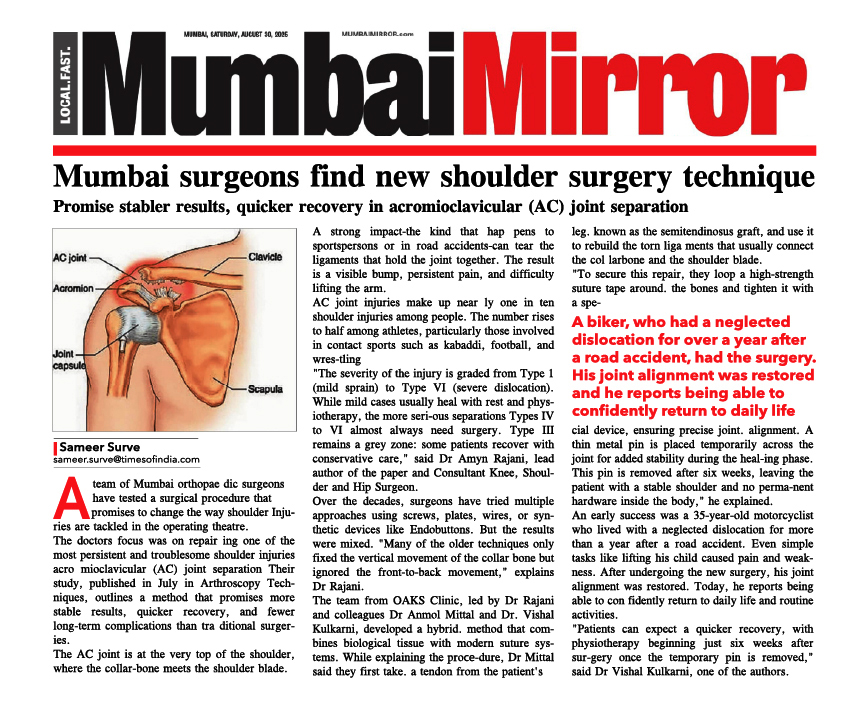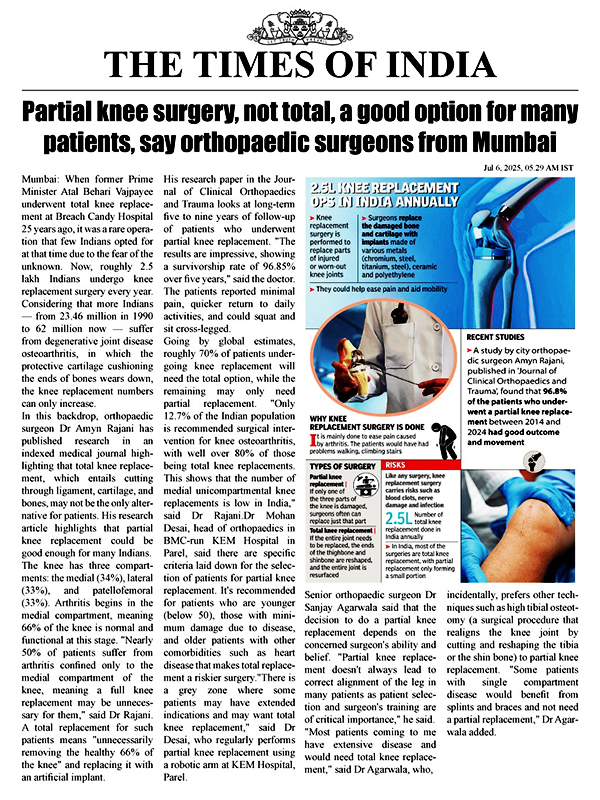When faced with knee pain or instability, understanding your diagnosis and treatment options is crucial. Two common knee injuries that sometimes require surgery involve the Medial Patellofemoral Ligament (MPFL) and the Anterior Cruciate Ligament (ACL). A question many patients ask is, "Is MPFL surgery worse than ACL surgery?" The answer isn't simple, as "worse" is subjective and depends on several factors, including the nature of the injury, the surgical procedure, and the recovery process.
To provide a clear understanding, we'll break down the differences and similarities between MPFL and ACL surgery, helping you make an informed decision with a trusted knee specialist in Mumbai like Dr. Amyn Rajani.
Understanding the Role of the MPFL and ACL
The knee joint is a complex structure of bones, ligaments, tendons, and cartilage working together to provide stability and movement. Two of the most vital ligaments are the MPFL and the ACL.
- MPFL (Medial Patellofemoral Ligament):
The MPFL is a thin but strong ligament on the inner side of the knee. Its primary job is to keep the patella (kneecap) from dislocating or moving too far to the outside of the knee. An MPFL tear typically occurs when the kneecap dislocates, a common injury in young athletes or those with anatomical predispositions like a shallow trochlear groove (the groove in the thigh bone where the kneecap sits). - ACL (Anterior Cruciate Ligament):
The ACL is one of the four main ligaments that stabilize the knee. Located deep within the knee joint, it prevents the shin bone (tibia) from sliding forward in relation to the thigh bone (femur). ACL tears are a frequent injury in sports that involve sudden stops, pivots, and changes in direction, such as football, basketball, and skiing.
The Surgical Procedures: MPFL vs. ACL Reconstruction
The surgical approach for these two injuries differs significantly, which directly impacts the recovery and overall experience.
MPFL Reconstruction
MPFL reconstruction is a less invasive procedure than ACL surgery. It aims to restore the stability of the kneecap. The procedure involves creating a new MPFL using a small tendon graft, often taken from the patient's own hamstring. The surgeon makes small incisions to attach this new ligament, ensuring the patella tracks correctly within the trochlear groove.
Key aspects of the procedure:
- Minimally Invasive: It is an arthroscopic or open procedure with small incisions.
- Targeted Repair: Focuses specifically on stabilizing the kneecap.
- Graft Options: Uses a hamstring tendon or a synthetic graft.
ACL Reconstruction
ACL reconstructionx` is a more complex and common procedure. The goal is to replace the torn ligament to restore stability to the entire knee joint. Similar to MPFL surgery, it involves using a graft to create a new ligament. The graft can be a piece of the patient's own patellar tendon, hamstring tendon, or a cadaver tendon (allograft). The surgeon drills tunnels into the thigh bone and shin bone to secure the new graft in the correct anatomical position.
Key aspects of the procedure:
- More Extensive: Requires more extensive drilling and fixation to replace the deep-seated ligament.
- Graft Options: Includes autografts (hamstring, patellar, or quadriceps tendon) and allografts (cadaver).
- Anatomical Precision: Precision is critical to restore the knee's natural motion and stability.
The "Worse" Factor: Comparing Recovery and Outcomes
When we ask if one surgery is "worse" than the other, we are typically referring to the pain, recovery timeline, and potential complications. Here’s a detailed comparison.
Pain and Post-Operative Experience
ACL Surgery: Patients often report significant post-operative pain, which is managed with medication. The knee is usually placed in a brace, and crutches are used for several weeks. The initial swelling and stiffness can be considerable.
MPFL Surgery: Pain is generally less severe compared to ACL reconstruction. While there is still some swelling and discomfort, many patients find the recovery more manageable. The use of a brace and crutches is also common but can sometimes be for a shorter duration.
Recovery and Rehabilitation
The rehabilitation journey is where the most significant differences lie.
ACL Surgery: The recovery is a long and arduous process, typically taking 6 to 9 months, and sometimes even a full year, to return to sports and high-impact activities. The rehab focuses on restoring range of motion, strengthening the quadriceps and hamstring muscles, and regaining proprioception (the sense of where your joint is in space). Patients work with a physical therapist multiple times a week to progress through a structured program.
MPFL Surgery: The recovery timeline is often shorter, with many patients returning to their normal daily activities in 3 to 4 months. While formal physical therapy is still essential, the focus is on strengthening the vastus medialis obliquus (VMO) muscle, a key stabilizer for the kneecap. The overall intensity and duration of the rehab are often less demanding than that for an ACL.
Potential Complications
Both surgeries have risks, but they are different.
- ACL Surgery: Risks include graft failure (the new ligament tearing), stiffness (arthrofibrosis), and nerve or blood vessel damage. The risk of re-injury is a major concern, particularly for athletes.
- MPFL Surgery: Complications are less common but can include recurrent kneecap instability, over-tightening of the graft (leading to kneecap pain), and hardware-related issues if fixation devices are used.
Why One Might Be "Worse" for You
Ultimately, whether MPFL or ACL surgery is "worse" depends on your individual circumstances.
- From a surgical and recovery standpoint, ACL surgery is generally considered the more demanding procedure. It involves a more complex reconstruction and a longer, more intensive rehabilitation period. The higher rate of re-injury, especially in athletes, can make the psychological and physical journey more challenging.
- However, from a functional perspective, a torn ACL can be "worse" for an active individual. An untreated ACL tear leads to significant knee instability, which can damage other structures like the meniscus and articular cartilage, potentially leading to early-onset arthritis. While an MPFL tear causes kneecap dislocation, it doesn't always lead to the same level of long-term joint damage if left untreated.
The Importance of a Knee Specialist
Regardless of the injury, the most critical factor is seeking treatment from an experienced knee specialist in Mumbai. A surgeon with expertise in both arthroscopic and open knee procedures, like Dr. Amyn Rajani, can accurately diagnose your condition and recommend the most suitable treatment.
Dr. Amyn Rajani is a renowned joint replacement surgeon in Mumbai and a knee surgeon in Mumbai with extensive experience in sports injuries, joint replacement, and arthroscopic procedures. He is also one of the best robotic knee replacement surgeon in Mumbai, utilizing advanced technology for precision and better patient outcomes. His expertise ensures that whether you need an MPFL or ACL reconstruction, or even a total knee replacement, you receive the highest level of care.
The Verdict and Your Next Step
Neither MPFL nor ACL surgery is inherently "worse" than the other, but ACL surgery is typically a more extensive procedure with a longer and more challenging recovery. The right choice of treatment is always a personalized one, based on a comprehensive diagnosis and consultation.
If you are experiencing knee pain, instability, or have been diagnosed with an MPFL or ACL injury, don't delay. Consulting a top knee specialist in Mumbai is the first and most important step toward recovery. Schedule an appointment with Dr. Amyn Rajani today to discuss your condition and embark on a clear path to getting back on your feet.





